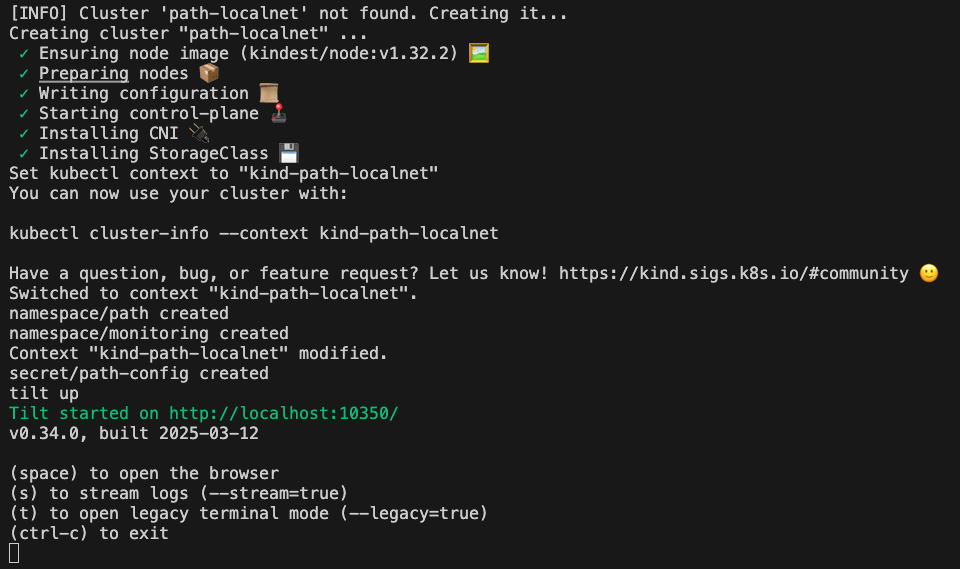Shannon Cheat Sheet (30-60 min)
This guide covers setting up PATH with Pocket Network's Shannon protocol.
Shannon is in Beta TestNet as of 01/2025 and private MainNet as of 04/2025.
If you are arriving here from the App & PATH Gateway Cheat Sheet
in the poktroll documentation, you should start the walkthrough from 2.1 Generate Shannon Config.
Table of Contents
- 0. Prerequisites
- 1. Setup Shannon Protocol Accounts (Gateway & Application)
- 2. Configure PATH for Shannon
- 3. Run PATH in development mode
- 4. Test Relays
0. Prerequisites
- Prepare your environment by following the instructions in the environment setup guide.
- Install the
pocketdCLI to interact with Pocket Network's Shannon Network.
You can use the make install_deps command to install the dependencies for the PATH stack, including the pocketd CLI.
1. Setup Shannon Protocol Accounts (Gateway & Application)
Before starting, you'll need to create and configure:
- An onchain Gateway: An onchain actor that facilitates (i.e. proxies) relays to ensure Quality of Service (QoS)
- An onchain Application: An onchain actor that pays (i.e. the API key holder) for relays
1.1 Gateway and Application Account Creation
We strongly recommend following the App & PATH Gateway Cheat Sheet for setting up your accounts and getting a thorough understanding of all the elements.
But, if this is your first time going through the docs, you can follow the copy-pasta instructions below to get a feel for the end-to-end process.
tl;dr Copy-pasta to stake onchain Application & Gateway
Prepare a gateway stake config:
cat <<🚀 > /tmp/stake_gateway_config.yaml
stake_amount: 1000000upokt
🚀
Prepare an application stake config:
cat <<🚀 > /tmp/stake_app_config.yaml
stake_amount: 100000000upokt
service_ids:
- "anvil"
🚀
Create gateway and application accounts in your keyring:
pocketd keys add gateway
pocketd keys add application
Fund the accounts by finding a link to the faucet here.
You can manually fund the accounts using the pkd_beta_tx helper by following the instructions in this notion doc:
pkd_beta_tx bank send faucet_beta $(pkd keys show -a application) 6900000000042upokt
pkd_beta_tx bank send faucet_beta $(pkd keys show -a gateway) 6900000000042upokt
Stake the gateway:
pocketd tx gateway stake-gateway \
--config=/tmp/stake_gateway_config.yaml \
--from=gateway --gas=auto --gas-prices=200upokt --gas-adjustment=1.5 --chain-id=pocket-beta \
--node=https://shannon-testnet-grove-rpc.beta.poktroll.com \
--yes
Stake the application:
pocketd tx application stake-application \
--config=/tmp/stake_app_config.yaml \
--from=application --gas=auto --gas-prices=200upokt --gas-adjustment=1.5 --chain-id=pocket-beta \
--node=https://shannon-testnet-grove-rpc.beta.poktroll.com \
--yes
Delegate from the application to the gateway:
pocketd tx application delegate-to-gateway $(pocketd keys show -a gateway) \
--from=application --gas=auto --gas-prices=200upokt --gas-adjustment=1.5 --chain-id=pocket-beta \
--node=https://shannon-testnet-grove-rpc.beta.poktroll.com \
--yes
1.2 Application and Gateway Account Validation
After following the instructions above, you should have keys with the names gateway and application in your keyring.
You can validate it like so:
# All accounts
pocketd keys list
# Gateway only
pocketd keys show -a gateway
# Application only
pocketd keys show -a application
2. Configure PATH for Shannon
2.1 Generate Shannon Config
Run the following command to generate a Shannon config at local/path/.config.yaml:
make shannon_populate_config
This command relies on pocketd command line interface to export the Gateway and Application address from your keyring backend.
You can set the following environment variables to override the default values:
POCKETD_HOME: Path to thepocketdhome directory (default$HOME/.pocketd)POCKETD_KEYRING_BACKEND: Keyring backend to use (defaulttest)
2.2 Manual Configuration Verification
Check your config file:
cat local/path/.config.yaml
It should look similar to the following with the gateway_config filled out.
shannon_config:
full_node_config:
rpc_url: https://shannon-testnet-grove-rpc.beta.poktroll.com
grpc_config:
host_port: shannon-testnet-grove-grpc.beta.poktroll.com:443
lazy_mode: false
gateway_config:
gateway_mode: "centralized"
gateway_address: pokt1... # Your gateway address
gateway_private_key_hex: "0x..." # Your gateway private key
owned_apps_private_keys_hex:
- "0x..." # Your application private key
2.3 Ensure onchain configuration matches
Double check the onchain configuration are configured for the service_ids you expect.
Repeat this command for each addresses associated with owned_apps_private_keys_hex.
pocketd query application show-application \
$(pkd keys show -a application) \
--node=https://shannon-testnet-grove-rpc.beta.poktroll.com
2.4 (Optional) Disable QoS Hydrator Checks
By default, the QoS hydrator will run checks against all services that applications configured in the shannon_config.owned_apps_private_keys_hex section are staked for.
To manually disable QoS checks for a specific service, the qos_disabled_service_ids field may be specified in the .config.yaml file.
This is primarily useful for testing and development purposes. It is unlikely you'll need this feature unless you are customizing QoS modules yourself.
For more information, see:
To see the list of services that PATH is configured for, you can use the /healthz endpoint.
curl http://localhost:3069/healthz
3. Run PATH in development mode
3.1 Start PATH
Run PATH in local development mode in Tilt by running:
make path_up
You can stop the PATH stack by running:
make path_down
3.2 Monitor PATH
It could take a few minutes for path, guard and watch to start up the first time.
You should see an output similar to the following relatively quickly (~30 seconds):

Once you see the above log, visit localhost:10350 to view the Tilt dashboard.

4. Test Relays
tl;dr Retry the requests below if the first one fails.
The instructions above were written to get you to access an anvil node accessible on Pocket Network.
Since anvil is an Ethereum node used for testing, there is a chance it may not be available.
We recommend you try the instructions below a few times to ensure you can get a successful relay. Otherwise, reach out to the community on Discord.
Test Relay with curl
Send a test relay to check the height of
curl http://localhost:3070/v1 \
-H "Target-Service-Id: anvil" \
-H "Authorization: test_api_key" \
-d '{"jsonrpc": "2.0", "id": 1, "method": "eth_blockNumber" }'
And you should expect to see a response similar to the following:
{"id":1,"jsonrpc":"2.0","result":"0x2f01a"}%
Test Relay with make
For your convenience, we have provided a few makefile helpers to test relays with curl and jq.
You can find that in the makefiles/test_requests.mk file.
For example, to mimic the curl command above, you can simply run:
make test_request__shannon_service_id_header
To see all available helpers, simply run:
make help
Load Testing with relay-util
You can use the relay-util tool to load test your relays.
The following will send 100 requests to the anvil node and give you performance metrics.
make test_request__shannon_relay_util_100
Add a screenshot of the output.